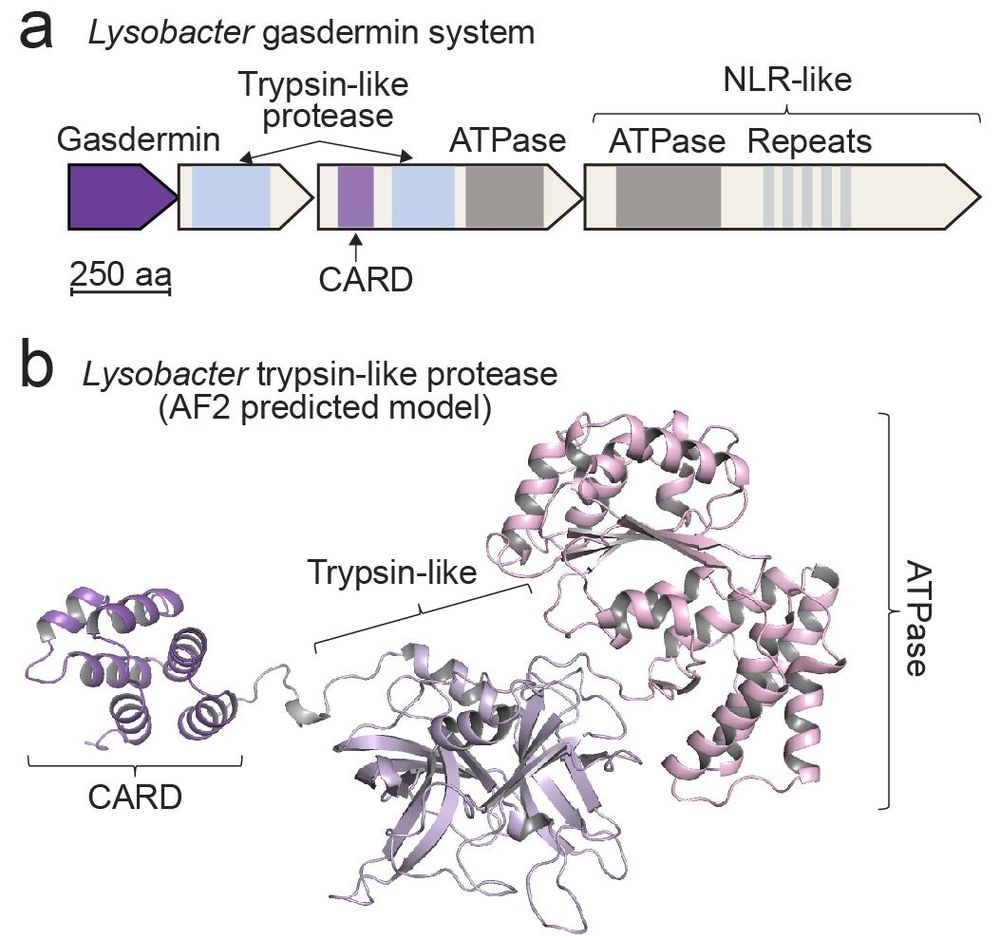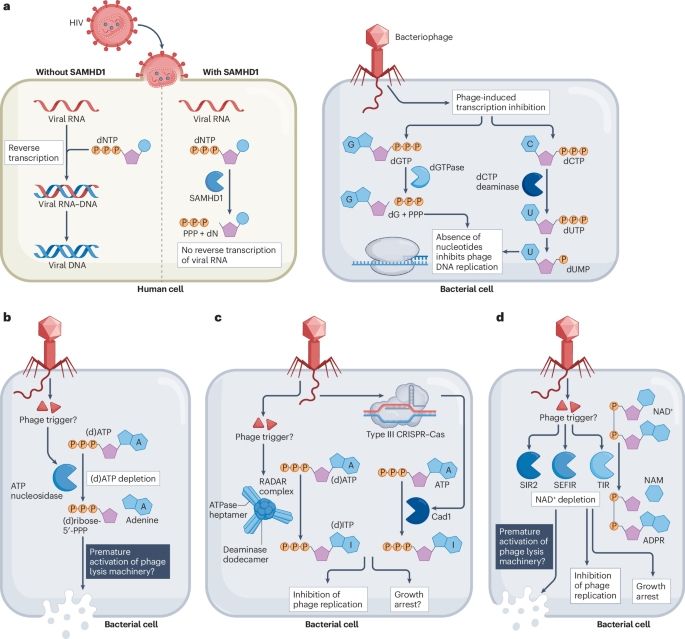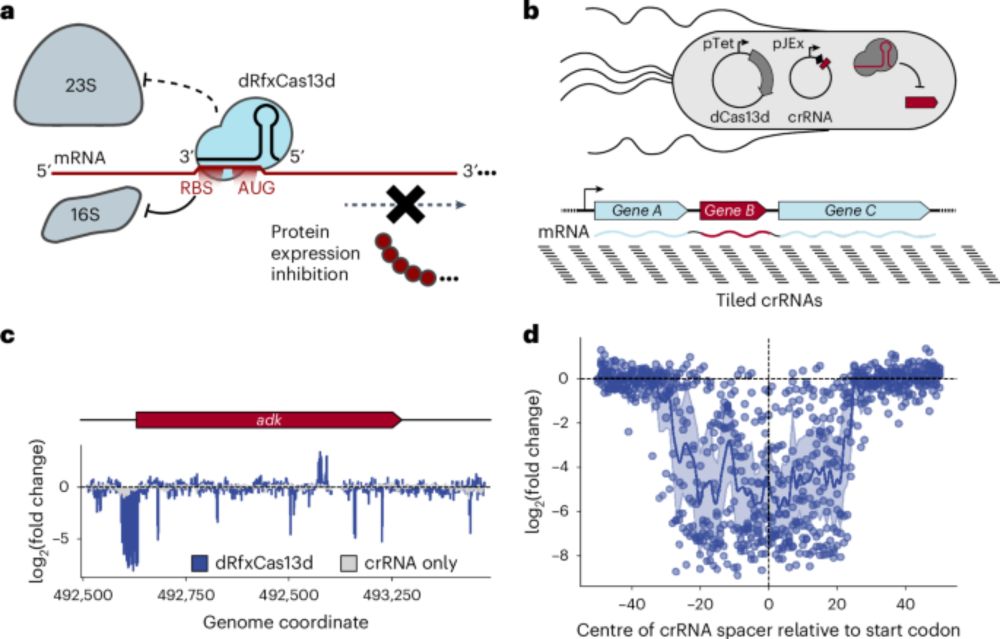
Megaplasmids associate with Escherichia coli and other Enterobacteriaceae
Humans and animals are ubiquitously colonized by Enterobacteriaceae , a bacterial family that contains both commensals and clinically significant pathogens. Here, we report Enterobacteriaceae megaplas...
New pre-print from the Banfield lab, highlighting an interesting case of 1.5Mb megaplasmids found in human gut.
Plasmid genomes were resolved using #PacBio HiFi sequencing with hifiasm-meta for #metagenome assembly. Host association was detected using epigenetic signals.
doi.org/10.1101/2025...
01.10.2025 16:43 — 👍 47 🔁 20 💬 1 📌 2

A miniature CRISPR–Cas10 enzyme confers immunity by inhibitory signalling - Nature
Panoptes, an anti-phage defence system against virus-mediated immune suppression, is revealed.
Today in @nature.com , we highlight how a cousin of CRISPR-Cas10, mCpol, establishes an evolutionary trap in anti-phage immune systems.
Check out @erinedoherty.bsky.social and my work from @doudna-lab.bsky.social lab here:
www.nature.com/articles/s41...
01.10.2025 17:56 — 👍 104 🔁 54 💬 3 📌 2


Some pics of our awesome PhD candidate, @sophswartz.bsky.social, presenting at the Cold Spring Harbor Laboratory conference!
25.08.2025 20:43 — 👍 10 🔁 1 💬 0 📌 0

Divergent viral phosphodiesterases for immune signaling evasion
Cyclic dinucleotides (CDNs) and other short oligonucleotides play fundamental roles in immune system activation in organisms ranging from bacteria to humans. In response, viruses use phosphodiesterase...
Excited to share our new preprint co-led by @jnoms.bsky.social!
Here we reveal an exceptional diversity of viral 2H phosphodiesterases (PDEs) that enable immune evasion by selectively degrading oligonucleotide-based messengers. This 2H PDE fold has evolved striking substrate breath & specificity.
22.08.2025 19:02 — 👍 42 🔁 28 💬 2 📌 2
Congrats and best of luck!
18.08.2025 19:54 — 👍 2 🔁 0 💬 1 📌 0
Very happy to share that I will be starting my lab at AITHYRA in October! My lab will use structural bioinformatics and functional genomics to understand the function of viral proteins, with a special emphasis on understanding how viruses subvert innate immunity.
15.08.2025 19:54 — 👍 34 🔁 5 💬 4 📌 1
‼️ New pre-print from co-leads @owentuck.bsky.social and Jason Hu! Check out this fascinating example of how coevolution enables defense system innovation.
29.07.2025 21:18 — 👍 26 🔁 9 💬 0 📌 0
Thanks Luuk!
29.07.2025 19:06 — 👍 1 🔁 0 💬 0 📌 0
Absolutely! Caspases seem particularly useful for proenzyme activation… 🧐
29.07.2025 18:44 — 👍 1 🔁 0 💬 0 📌 0
Congratulations!
29.07.2025 18:43 — 👍 1 🔁 0 💬 0 📌 0
Thanks Jason!
29.07.2025 16:03 — 👍 1 🔁 0 💬 0 📌 0
This work was co-led by Jason Hu and would not have been possible without wonderful colleagues/coauthors in the @doudna-lab.bsky.social including @benadler.bsky.social, Claire, Santi, Kendall, Charlotte, @erinedoherty.bsky.social and @arushi-lahiri.bsky.social
29.07.2025 16:02 — 👍 3 🔁 0 💬 0 📌 0
Recurrent acquisition of nuclease-protease pairs in antiviral immunity https://www.biorxiv.org/content/10.1101/2025.07.28.667249v1
29.07.2025 04:17 — 👍 9 🔁 6 💬 0 📌 1
Beautiful study - congratulations!
18.03.2025 00:23 — 👍 1 🔁 0 💬 1 📌 0

Our paper out @Nature: CARD domains mediate anti-phage defense in bacterial gasdermin systems
CARDs are essential for caspase recruitment during human inflammasome activation. We now find them in bacterial immune systems
Congrats Tana Wein! Thank you Kranzusch lab!
www.nature.com/articles/s41...
30.01.2025 03:40 — 👍 194 🔁 67 💬 4 📌 6
👋 Hi antiphage defense community, we are soon releasing an update of DefenseFinder.
We are doing our best to include all the great discoveries from the community, but with so much going on we might miss things.
Please answer wt preprints/papers with new systems or mail/git them to us. 🙏
13.01.2025 13:54 — 👍 60 🔁 37 💬 3 📌 0
My friend @benadler.bsky.social and I co-led this work. Huge thanks to collaborators Emily Armbruster & Joe Pogliano, as well as talented Berkeley MCB students Arushi Lahiri, Jason Hu (a star roton), and Julia Zhou (since graduated!). Lastly, we're indebted to Jennifer for her support. 14/14
01.03.2024 23:53 — 👍 4 🔁 1 💬 0 📌 0
Beyond mechanistic insights into a fascinating immune system, we hope to highlight the diverse and integral functions of helicases in immunity. 13/14
01.03.2024 23:50 — 👍 2 🔁 0 💬 1 📌 0
There are functional symmetries and phylogenetic relationships between HamB and the Ski2-like recombination helicase Hel308. Hel308 is only present in archaea and metazoans. Could the two be evolutionarily linked? 12/14
01.03.2024 23:50 — 👍 2 🔁 1 💬 1 📌 0

We propose Hachiman activates in response to abberant DNA states. DNA ends load into the helicase, triggering ATP hydrolysis and release of HamA. HamA chews up DNA, potentially amplifying the immune response by creating more sites for HamAB loading. 11/14
01.03.2024 23:49 — 👍 2 🔁 1 💬 1 📌 0

In another cryo-EM structure, we visualized nuclease-dead HamAB binding intact DNA in an orthogonal mode. We imagine this 'sliding' or binding state enables the helicase to thread ssDNA lesions into the active site. 10/14
01.03.2024 23:48 — 👍 3 🔁 0 💬 1 📌 0

But why is Hachiman so effective against diverse phages? The trigger must be central to phage infection. We show that direct DNA damage induced by a drug activates Hachiman in the absence of phage! This key insight implies HamAB recognizes DNA damage as a viral signature. 9/14
01.03.2024 23:47 — 👍 2 🔁 0 💬 1 📌 0

Our collaborators Emily Armbruster and Joe Pogliano @ucsd showed Hachiman in action. When infected with phage, HamB completely shreds both phage and host DNA, leaving behind "phantom cells" devoid of genomes. Infected cells sacrifice themselves in service of the colony. 8/14
01.03.2024 23:47 — 👍 3 🔁 0 💬 1 📌 0

In another surprise, we discovered HamB is a DNA helicase! A set of structures shows DNA entering the HamB active site. We resolved 'ratcheting' states that lead to large domain movements upon activation. This motion may release the HamA nuclease. 7/14
01.03.2024 23:46 — 👍 2 🔁 0 💬 1 📌 0

The structure led us to identify an active site for the HamA DUF! HamA is a nuclease homologous to nucleases in Type IIS restriction modification systems. HamA insertions mediate binding to HamB. The HamAB complex cuts DNA in vitro. 6/14
01.03.2024 23:45 — 👍 2 🔁 0 💬 1 📌 0

To get at the mechanism, we turned to cryo-EM. HamA and HamB form a heterodimeric complex, with HamA contacting an N-terminal helical bundle in HamB. 5/14
01.03.2024 23:44 — 👍 2 🔁 0 💬 1 📌 0
Located at the University of California-Berkeley at the Innovative Genomics Institute.
Purveyors of Microbial Ecology, Bioinformatics, & Nanogeoscience.
Reposts or likes≠endorsements.
https://www.banfieldlab.com/
Conceptual synthesis uniting biology's macro- and microbiological worlds into an enveloping representation of life. Holobiont = host and all associated microbes. Hologenome = all of their genomes.
Link: https://www.science.org/doi/10.1126/science.ado2152
Phage Biology, Bacterial defense systems, CRISPR-Cas, Microbial communities, Mucus interactions
http://www.fnobregalab.org
http://www.klebphacol.org
http://www.phage-collection.org
enthusiast of transposable elements, genetic conflicts, small RNAs, Drosophila, and funky germline biology
running a lab at IMBA, Vienna BioCenter
https://www.oeaw.ac.at/imba/research/julius-brennecke
Columbia PhD candidate studying viral RNA structure and degradation
To promote a collegial community of international scientists, to enhance scientific collaboration and communication, and to advance medical education and biomedical research.
Assistant Professor of all things fungi, from their nifty viruses to their inevitable demise 🍄 @NSfungiLab @HUJIAgri
PhD Candidate in the Kranzusch Lab at Harvard Medical School / studying mechanisms of viral immune evasion
Nimble funding for nimble minds.
www.hypothesisfund.org
Assistant Professor of Applied Physics @Stanford. Theoretical biophysics. Evolutionary dynamics. Microbial evolution. https://bgoodlab.github.io/
Evolutionary genetics and cell biology. And co-host of This Week in Evolution: www.microbe.tv/twievo/ Elde lab: cellvolution.org
Higgins Professor of Biochemistry & Molecular Biophysics at Columbia University | Genome Integrity & DNA Repair Mechanisms | Single Molecule Biophysics | https://substack.com/@ericcgreene
Microbial cell-cell interactions | contractile injection systems | cytoskeleton | evolution | multiscale imaging | ETH Zürich
- run by lab members -
Postdoc at Karolinska Institutet in Andrea Fossati's lab studying phage-based antimicrobials with proteomics and functional genomics
Structural biologist and biochemist. CNRS researcher at CBM Orléans @cbm-upr4301.bsky.social. Interested in protein modifications & interactions. Also husband, dad of 2, friend, ☧. Personal website: msuskiewicz.github.io
Incoming Assistant Professor, Columbia University | @DamonRunyon.org Postdoc, UC Berkeley | PhD Princeton University | Mobile elements, Structural biology and Genome engineering | http://thawanilab.org
PhD candidate in the Hornung Lab || Prev @Astrazeneca @GSK
Assistant Professor, Department of Microbiology, UT Southwestern. Posts are my own.
Lab Website: forsberglab.org
Banner Art: Tamanash Bhattacharya
Plant researcher at Indiana University
~ plant pathogen interactions ~
also janky cats, tropical fruit trees, tiny goats
Apprentice Petalsmith
















